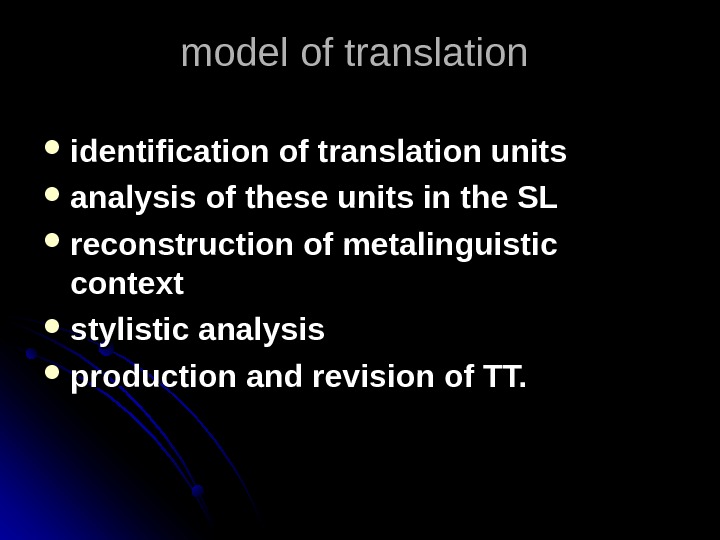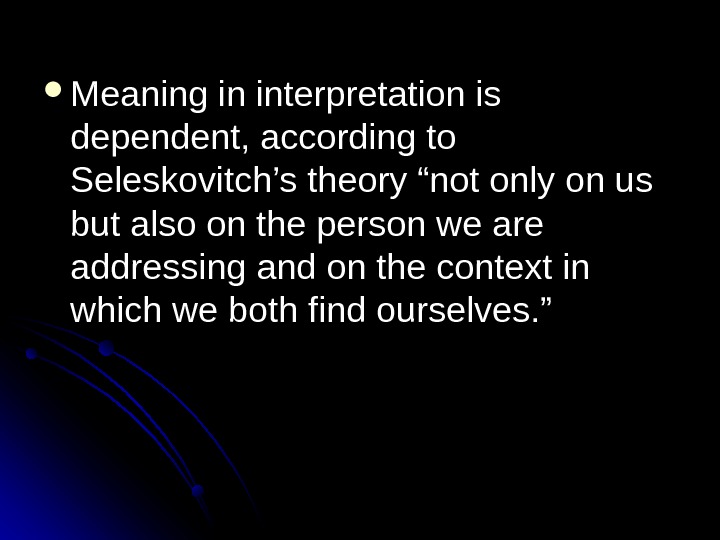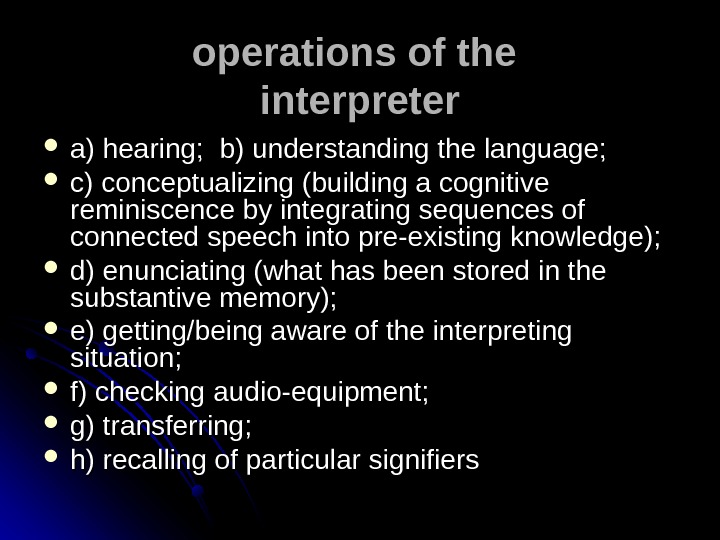TRANSLATION STUDIES IN FRANCE AND CANADA 1. 1.


























translation_studies_in_france_and_canada.ppt
- Размер: 10.3 Mегабайта
- Количество слайдов: 25
Описание презентации TRANSLATION STUDIES IN FRANCE AND CANADA 1. 1. по слайдам
 TRANSLATION STUDIES IN FRANCE AND CANADA 1. 1. Background to Literary Translation in Canada 2. 2. Jean-Paul Vinay and Jean Darbelnet 3. 3. Georges Mounin 4. 4. Danica Seleskovitch and Marianne Lederer. The Interpretive Theory 5. 5. Jean Delisle 6. 6. Judith Woodsworth
TRANSLATION STUDIES IN FRANCE AND CANADA 1. 1. Background to Literary Translation in Canada 2. 2. Jean-Paul Vinay and Jean Darbelnet 3. 3. Georges Mounin 4. 4. Danica Seleskovitch and Marianne Lederer. The Interpretive Theory 5. 5. Jean Delisle 6. 6. Judith Woodsworth
 Background to Literary Translation in Canada Jacques Cartier 1534 Iroquois BNA Act of 1867 — — The British North America Act English-Canadian and Quebec literary production
Background to Literary Translation in Canada Jacques Cartier 1534 Iroquois BNA Act of 1867 — — The British North America Act English-Canadian and Quebec literary production
 1971 the Canada Council Translation Grant program 1975 the Literary Translators’ Association Ellipse (1969), Meta (1966), and TTRTTR (1987) Philip Stratford’s 1977 Bibliography of Canadian Books in Translation: French to English and English to French
1971 the Canada Council Translation Grant program 1975 the Literary Translators’ Association Ellipse (1969), Meta (1966), and TTRTTR (1987) Philip Stratford’s 1977 Bibliography of Canadian Books in Translation: French to English and English to French
 Jean-Paul Vinay and Jean Darbelnet (1904 -1990) Paris the Sorbonne Wales, Edinburgh and Manchester 1938 -39 at Harvard 1940 Canada Mc. Gill University Bowdoin College and Laval University
Jean-Paul Vinay and Jean Darbelnet (1904 -1990) Paris the Sorbonne Wales, Edinburgh and Manchester 1938 -39 at Harvard 1940 Canada Mc. Gill University Bowdoin College and Laval University
 Jean-Paul Vinay (1910 -1999) Paris the Sorbonne MA in Phonetics and Philology 1937 French army 1939 -40 liaison officer with the British Expeditionary Forces 1946 Canada the University of Montréal professor and head of the department of Linguistics and Translation the bilingual Canadian Dictionary 1962 a television course Speaking French 1967 the University of Victoria in British Columbia
Jean-Paul Vinay (1910 -1999) Paris the Sorbonne MA in Phonetics and Philology 1937 French army 1939 -40 liaison officer with the British Expeditionary Forces 1946 Canada the University of Montréal professor and head of the department of Linguistics and Translation the bilingual Canadian Dictionary 1962 a television course Speaking French 1967 the University of Victoria in British Columbia
 . . Comparative Stylistics of French and English Direct methods of translating 1. 1. Borrowing 2. 2. Calque 3. 3. literal translation
. . Comparative Stylistics of French and English Direct methods of translating 1. 1. Borrowing 2. 2. Calque 3. 3. literal translation
 Procedure 1: Borrowing To overcome a lacuna, usually a metalinguistic one (e. g. a new technical process, unknown concept) borrowing is the simplest of all translation method Many borrowings enter a language through translation, just like semantic borrowings or or faux amis , whose pitfalls translators must carefully avoid.
Procedure 1: Borrowing To overcome a lacuna, usually a metalinguistic one (e. g. a new technical process, unknown concept) borrowing is the simplest of all translation method Many borrowings enter a language through translation, just like semantic borrowings or or faux amis , whose pitfalls translators must carefully avoid.
 Procedure 2: Loan translation a special kind of borrowing whereby a language borrows an expression form of another, but then translates literally each of its elements. lexical loan structural loan
Procedure 2: Loan translation a special kind of borrowing whereby a language borrows an expression form of another, but then translates literally each of its elements. lexical loan structural loan
 Procedure 3: Literal translation Literal, or word for word, translation is the direct transfer of a source text into a grammatically and idiomatically appropriate target language text in which the translator’s task is limited to observing the adherence to the linguistic servitude of the target text.
Procedure 3: Literal translation Literal, or word for word, translation is the direct transfer of a source text into a grammatically and idiomatically appropriate target language text in which the translator’s task is limited to observing the adherence to the linguistic servitude of the target text.
 Oblique methods of translating transposition (change from one part of speech in the ST to another in the TT) , , modulation (change in semantics and point of view) equivalence (different languages describing a situation by different means, e. g. idioms) adaptation (changing cultural reference).
Oblique methods of translating transposition (change from one part of speech in the ST to another in the TT) , , modulation (change in semantics and point of view) equivalence (different languages describing a situation by different means, e. g. idioms) adaptation (changing cultural reference).
 model of translation identification of translation units analysis of these units in the SL reconstruction of metalinguistic context stylistic analysis production and revision of TT.
model of translation identification of translation units analysis of these units in the SL reconstruction of metalinguistic context stylistic analysis production and revision of TT.
 Georges Mounin (1910 -1993) pseudonym de Louis Leboucher French linguist , professor of linguistics Les Belles infidèles. Essai sur la traduction 1955 Les Problèmes théoriques de la traduction, 1963 La Machine à traduire, 1964. Linguistique et traduction, 1976.
Georges Mounin (1910 -1993) pseudonym de Louis Leboucher French linguist , professor of linguistics Les Belles infidèles. Essai sur la traduction 1955 Les Problèmes théoriques de la traduction, 1963 La Machine à traduire, 1964. Linguistique et traduction, 1976.
 The Interpretive Theory of Translation Danica Seleskovitch and Marianne Lederer Études traductologiques : en hommage à Danica Seleskovitch, textes réunis par Marianne Lederer, Lettres modernes, 1990. Fortunato Israël et Marianne Lederer (eds) La Théorie Interprétative de la Traduction (Vol. I: genèse et développement, Vol. II. convergences, mises en perspectives, Vol. III. de la formation. . . à la pratique professionnelle), lettres modernes minard, 2005. Anne-Marie Widlund-Fantini, Danica Seleskovitch — Interprète et témoin du XXe siècle, éditions de l’Age d’Homme,
The Interpretive Theory of Translation Danica Seleskovitch and Marianne Lederer Études traductologiques : en hommage à Danica Seleskovitch, textes réunis par Marianne Lederer, Lettres modernes, 1990. Fortunato Israël et Marianne Lederer (eds) La Théorie Interprétative de la Traduction (Vol. I: genèse et développement, Vol. II. convergences, mises en perspectives, Vol. III. de la formation. . . à la pratique professionnelle), lettres modernes minard, 2005. Anne-Marie Widlund-Fantini, Danica Seleskovitch — Interprète et témoin du XXe siècle, éditions de l’Age d’Homme,
 Danica Seleskovitch (1921 -2001) teacher of conference interpreting a researcher and theorist She founded the interpretation wing of the École Supérieure d’Interprètes et de Traducteurs (ESIT) at the University of Paris
Danica Seleskovitch (1921 -2001) teacher of conference interpreting a researcher and theorist She founded the interpretation wing of the École Supérieure d’Interprètes et de Traducteurs (ESIT) at the University of Paris
 Interpretation/interpreting is generally defined as oral translation and perceived as a more or less mechanical activity consisting in a series of encoding and decoding operations. ““ It is not the oral translation of words” — interpreting/interpretation is a complex and demanding activity: “it uncovers a meaning and makes it explicit for others. Interpretation is communication, i. e. analysis of the original message and its conversion.
Interpretation/interpreting is generally defined as oral translation and perceived as a more or less mechanical activity consisting in a series of encoding and decoding operations. ““ It is not the oral translation of words” — interpreting/interpretation is a complex and demanding activity: “it uncovers a meaning and makes it explicit for others. Interpretation is communication, i. e. analysis of the original message and its conversion.
 three stages of the process: 1. Auditory perception of a linguistic utterance which carries meaning. Apprehension of the language and comprehension of the message through a process of analysis and exegesis. 2. Immediate and deliberate discarding of the wording and retention of the mental representation of the message (concepts, ideas, etc. ) 3. Production of a new utterance in the target language which must meet a dual requirement: it must express the original message in its entirety and it must be geared to the recipient. ”
three stages of the process: 1. Auditory perception of a linguistic utterance which carries meaning. Apprehension of the language and comprehension of the message through a process of analysis and exegesis. 2. Immediate and deliberate discarding of the wording and retention of the mental representation of the message (concepts, ideas, etc. ) 3. Production of a new utterance in the target language which must meet a dual requirement: it must express the original message in its entirety and it must be geared to the recipient. ”
 Meaning in interpretation is dependent, according to Seleskovitch’s theory “not only on us but also on the person we are addressing and on the context in which we both find ourselves. ”
Meaning in interpretation is dependent, according to Seleskovitch’s theory “not only on us but also on the person we are addressing and on the context in which we both find ourselves. ”
 types of memory substantive memory retains/stores what has previously been understood/processed verbatim memory retains words
types of memory substantive memory retains/stores what has previously been understood/processed verbatim memory retains words
 Comprehension/processing of the meaning is difficult in either mode of interpreting, i. e. consecutive or simultaneous, owing to the oral nature of the message. In simultaneous, however, it seems impossible to achieve. Simultaneous interpreting makes it almost impossible for the interpreter to dissociate source language from target language. Being intensely exposed to the former and having to produce the latter almost instantly, the interpreter has no time to process meaning and therefore he is most liable to translate words instead of meaning.
Comprehension/processing of the meaning is difficult in either mode of interpreting, i. e. consecutive or simultaneous, owing to the oral nature of the message. In simultaneous, however, it seems impossible to achieve. Simultaneous interpreting makes it almost impossible for the interpreter to dissociate source language from target language. Being intensely exposed to the former and having to produce the latter almost instantly, the interpreter has no time to process meaning and therefore he is most liable to translate words instead of meaning.
 operations of the interpreter a) hearing; b) understanding the language; c) conceptualizing (building a cognitive reminiscence by integrating sequences of connected speech into pre-existing knowledge); d) enunciating (what has been stored in the substantive memory); e) getting/being aware of the interpreting situation; f) checking audio-equipment; g) transferring; h) recalling of particular signifiers
operations of the interpreter a) hearing; b) understanding the language; c) conceptualizing (building a cognitive reminiscence by integrating sequences of connected speech into pre-existing knowledge); d) enunciating (what has been stored in the substantive memory); e) getting/being aware of the interpreting situation; f) checking audio-equipment; g) transferring; h) recalling of particular signifiers
 Comprehension is what occurs when new information ties in with related knowledge. If such knowledge is absent the new information is ignore The Interpretive Theory is built upon four pillars: 1) command of the native language, 2) command of the source language, 3) command of relevant world and background knowledge, 4) command of interpreting methodology.
Comprehension is what occurs when new information ties in with related knowledge. If such knowledge is absent the new information is ignore The Interpretive Theory is built upon four pillars: 1) command of the native language, 2) command of the source language, 3) command of relevant world and background knowledge, 4) command of interpreting methodology.
 Interpretive Theory posits that methodologically the process of translating requires an understanding of sense (language meaning + cognitive complements) and a formulation of the translation on the basis of the synecdoche principle synecdoche A part of something may stand for the whole. A single item may represent a whole group. A concept may represent a connected concept.
Interpretive Theory posits that methodologically the process of translating requires an understanding of sense (language meaning + cognitive complements) and a formulation of the translation on the basis of the synecdoche principle synecdoche A part of something may stand for the whole. A single item may represent a whole group. A concept may represent a connected concept.
 Dr. Jean Delisle FRSC Professor of Translation and Interpretation University of Ottawa
Dr. Jean Delisle FRSC Professor of Translation and Interpretation University of Ottawa
 eight classes of translations on the basis of four characteristics: a) According to the function of the source text — pragmatic translation and literary translation b) According to the degree of specialization in the source text — general translation and specialized translation c) According to the general purpose of translating — academic translation and professional translation d) According to the translation approach used in producing the target text — transcoding and translation (proper)
eight classes of translations on the basis of four characteristics: a) According to the function of the source text — pragmatic translation and literary translation b) According to the degree of specialization in the source text — general translation and specialized translation c) According to the general purpose of translating — academic translation and professional translation d) According to the translation approach used in producing the target text — transcoding and translation (proper)
 Judith Woodsworth Translators Through History , editors Jean Delisle, Judith Woodsworth, John Benjamins Ph. D (born 1948) Paris BA in French and Philosophy from Mc. Gill University Ph. D. in French Literature from Mc. Gill. a Canadian academic and university administrator
Judith Woodsworth Translators Through History , editors Jean Delisle, Judith Woodsworth, John Benjamins Ph. D (born 1948) Paris BA in French and Philosophy from Mc. Gill University Ph. D. in French Literature from Mc. Gill. a Canadian academic and university administrator

